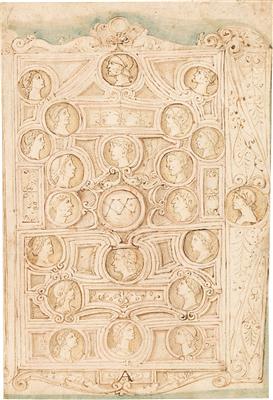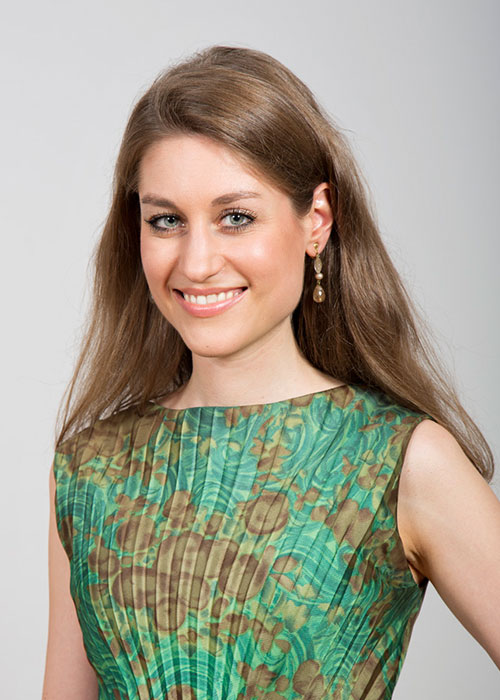North Italian school,

1500-1550, presumably commissioned by Isabelle d'Este (Ferrara 1474-1539 Mantua), a design for a frontispiece or for a cabinet determined for coins and gems (medagliere), pen and brown ink, brown, blue and red wash, on laid paper, 27,5 x 18,5 cm, unmounted, unframed, (Sch)
Provenance:
Cassiano dal Pozzo (Turin 1588–1657 Rome); Pope Clemens XI Albani (Urbino 1649–1721 Rome); Cardinal Alessandro Albani (Urbino 1692–1779 Rome); King Georges III of England (London 1738–1820 Windsor Castle); Richard Dalton (England c. 1715–1791); John MacGowan (Scottland 1726–1780); Charles Townley (England 1737–1805); William Stirling-Maxwell, auction sale Philipps, London, 12th December 1990, lot 2923 “Sculpture” Album Fol. 112, together with an architectural plan for a fountain by another artist (The Paper Museum of Cassiano dal Pozzo: A Catalogue Raisonné, „Renaissance and Later Architecture and Ornament drawings“, Cat. Nr. 110/111).
Literature:
The Paper Museum of Cassiano dal Pozzo: A Catalogue Raisonné, “Renaissance and Later Architecture and Ornament drawings”, Cat. No. 110/111; Ivy L. Mumford, “Some Decorative Aspects of the Imprese of Isabelle d’Este (1474–1539)”, in: Italian Studies, Volume 34, 1979, pp. 60–70; (upcoming publication): Elena Vaiani, Helen Whitehouse and Simonetta Prosperi Valenti Rodinò, The Paper Museum of Cassiano dal Pozzo: A Catalogue Raisonné, Part A. VIII: Egyptian and Roman Antiquities and Renaissance Decorative Arts, 2018.
The present drawing comes from the Museo Cartaceo, the socalled „paper museum“ of Cassiano dal Pozzo. During the 17th century the Roman patron and collector Cassiano dal Pozzo (Torino 1588-1657) and his brother Carlo Antonio collected more than 10.000 drawings, watercolours and prints. The collection comprised various documents of ancient art and culture, including architecture, zoology, botany, geology and social customs. Prior to the age of photography it represented in size and in its kind presumably the most significant attempt of creating a pictorial encyclopedia of human culture. The Museo Cartaceo offers insight in the intellectual environment and in the scientific interests of the time which anticipated the beginnings of modern science and research.
The „paper museum“ was sold to Pope Clemens XI (Urbino 1649–1721 Rome) by the heirs of Cassiano dal Pozzo in the early 18th century. It remained in the property of the Albani family until 1762 when the majority of the collection was acquired by King George III of England. This part of the collection is preserved in the Royal Library of Windsor Castle. The remaining works of the paper museum are kept in the British Museum, the British Library, the Institut de France and in other public and private collections. On December 12th, 1990 a significant part of the paper museum from the collection of Sir William Stirling-Maxwell was sold at Philipp’s in London.
The present drawing was part of an „album of sculptures“ (folio 112) and sold as lot 293 at the auction sale. It is a design for a frontispiece or for the door of a medal cabinet, a socalled „medagliere“ where coins and gems were kept. The number „27“ resp. „XXVII“ relates to one of the „imprese“ of Isabella d’Este, Duchess of Mantua (Ferrara 1474-1539 Mantua) which registered various symbols whose significance and meaning have hitherto been interpreted differently (see Mumford 1979, pp. 60 ff.). Due to these „imprese“ it is quite possible that the drawing was executed in connection with a project commissioned by Isabella d’Este.
The 21 medallions which show portraits of Roman Emperors are rendered in the archaic style of the 14th century. The paper shows a watermark („anchor in a circle with star“) which was frequently used in Italy in the 16th and 17th century. On the basis of stylistic criteria Paul Joannides suggested a possible attribution to Nicoletto da Modena (Italy, active in Modena c. 1500–1520).
We are grateful to Dr. Rea Alexandratos, Dr. Nicholas Turner and Prof. Paul Joannides for the scientific support in regard of cataloguing the present drawing. We are also grateful to Dr. Elena Vaiani, Dr. Helen Whitehouse and Prof. Simonetta Prosperi Valenti Rodinò, who will include the present drawing in the forthcoming catalogue of the „Paper museum“ in 2018 (see Literature)
Esperta: Mag. Astrid-Christina Schierz
 Mag. Astrid-Christina Schierz
Mag. Astrid-Christina Schierz
+43-1-515 60-546
astrid.schierz@dorotheum.at
27.03.2018 - 17:00
- Prezzo realizzato: **
-
EUR 3.000,-
- Stima:
-
EUR 2.400,- a EUR 3.000,-
- Prezzo di partenza:
-
EUR 0,-
North Italian school,
1500-1550, presumably commissioned by Isabelle d'Este (Ferrara 1474-1539 Mantua), a design for a frontispiece or for a cabinet determined for coins and gems (medagliere), pen and brown ink, brown, blue and red wash, on laid paper, 27,5 x 18,5 cm, unmounted, unframed, (Sch)
Provenance:
Cassiano dal Pozzo (Turin 1588–1657 Rome); Pope Clemens XI Albani (Urbino 1649–1721 Rome); Cardinal Alessandro Albani (Urbino 1692–1779 Rome); King Georges III of England (London 1738–1820 Windsor Castle); Richard Dalton (England c. 1715–1791); John MacGowan (Scottland 1726–1780); Charles Townley (England 1737–1805); William Stirling-Maxwell, auction sale Philipps, London, 12th December 1990, lot 2923 “Sculpture” Album Fol. 112, together with an architectural plan for a fountain by another artist (The Paper Museum of Cassiano dal Pozzo: A Catalogue Raisonné, „Renaissance and Later Architecture and Ornament drawings“, Cat. Nr. 110/111).
Literature:
The Paper Museum of Cassiano dal Pozzo: A Catalogue Raisonné, “Renaissance and Later Architecture and Ornament drawings”, Cat. No. 110/111; Ivy L. Mumford, “Some Decorative Aspects of the Imprese of Isabelle d’Este (1474–1539)”, in: Italian Studies, Volume 34, 1979, pp. 60–70; (upcoming publication): Elena Vaiani, Helen Whitehouse and Simonetta Prosperi Valenti Rodinò, The Paper Museum of Cassiano dal Pozzo: A Catalogue Raisonné, Part A. VIII: Egyptian and Roman Antiquities and Renaissance Decorative Arts, 2018.
The present drawing comes from the Museo Cartaceo, the socalled „paper museum“ of Cassiano dal Pozzo. During the 17th century the Roman patron and collector Cassiano dal Pozzo (Torino 1588-1657) and his brother Carlo Antonio collected more than 10.000 drawings, watercolours and prints. The collection comprised various documents of ancient art and culture, including architecture, zoology, botany, geology and social customs. Prior to the age of photography it represented in size and in its kind presumably the most significant attempt of creating a pictorial encyclopedia of human culture. The Museo Cartaceo offers insight in the intellectual environment and in the scientific interests of the time which anticipated the beginnings of modern science and research.
The „paper museum“ was sold to Pope Clemens XI (Urbino 1649–1721 Rome) by the heirs of Cassiano dal Pozzo in the early 18th century. It remained in the property of the Albani family until 1762 when the majority of the collection was acquired by King George III of England. This part of the collection is preserved in the Royal Library of Windsor Castle. The remaining works of the paper museum are kept in the British Museum, the British Library, the Institut de France and in other public and private collections. On December 12th, 1990 a significant part of the paper museum from the collection of Sir William Stirling-Maxwell was sold at Philipp’s in London.
The present drawing was part of an „album of sculptures“ (folio 112) and sold as lot 293 at the auction sale. It is a design for a frontispiece or for the door of a medal cabinet, a socalled „medagliere“ where coins and gems were kept. The number „27“ resp. „XXVII“ relates to one of the „imprese“ of Isabella d’Este, Duchess of Mantua (Ferrara 1474-1539 Mantua) which registered various symbols whose significance and meaning have hitherto been interpreted differently (see Mumford 1979, pp. 60 ff.). Due to these „imprese“ it is quite possible that the drawing was executed in connection with a project commissioned by Isabella d’Este.
The 21 medallions which show portraits of Roman Emperors are rendered in the archaic style of the 14th century. The paper shows a watermark („anchor in a circle with star“) which was frequently used in Italy in the 16th and 17th century. On the basis of stylistic criteria Paul Joannides suggested a possible attribution to Nicoletto da Modena (Italy, active in Modena c. 1500–1520).
We are grateful to Dr. Rea Alexandratos, Dr. Nicholas Turner and Prof. Paul Joannides for the scientific support in regard of cataloguing the present drawing. We are also grateful to Dr. Elena Vaiani, Dr. Helen Whitehouse and Prof. Simonetta Prosperi Valenti Rodinò, who will include the present drawing in the forthcoming catalogue of the „Paper museum“ in 2018 (see Literature)
Esperta: Mag. Astrid-Christina Schierz
 Mag. Astrid-Christina Schierz
Mag. Astrid-Christina Schierz
+43-1-515 60-546
astrid.schierz@dorotheum.at
|
Hotline dell'acquirente
lun-ven: 10.00 - 17.00
kundendienst@dorotheum.at +43 1 515 60 200 |
| Asta: | Disegni e stampe fino al 1900, acquarelli e miniature |
| Tipo d'asta: | Asta in sala |
| Data: | 27.03.2018 - 17:00 |
| Luogo dell'asta: | Wien | Palais Dorotheum |
| Esposizione: | 17.03. - 27.03.2018 |
** Prezzo d’acquisto comprensivo dei diritti d’asta acquirente e IVA
Non è più possibile effettuare un ordine di acquisto su Internet. L'asta è in preparazione o è già stata eseguita.
